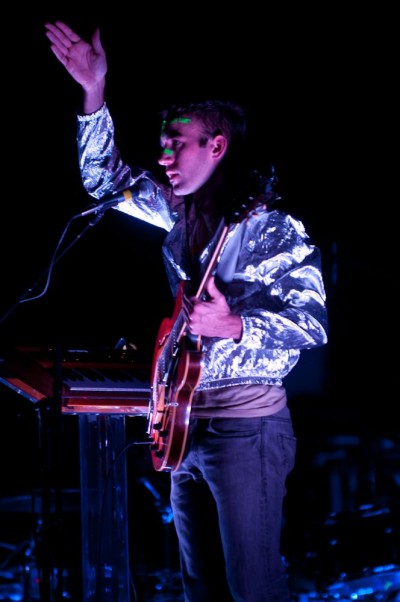Little about Sunday’s Sufjan Stevens show at the Thomas Wolfe Auditorium was expected, from surprisingly delightful opener D.M. Stith (who said he last played Asheville over the summer, at Club 828, to a crowd of 4: Do not miss his solo show when he returns) to animated projections paying homage to late Mississippi folk artist Royal Robertson, to the futuristic costume changes to the energetic backup dancers. In fact, it seemed at times that much of the show — though well-rehearsed (Stith, who also plays keys for Stevens, joked that the band rehearses 13 hours every day. Outside. Rain or shine.), choreographed and a multi-media-sensory-orgy-verging-on-overload from start to finish — was a surprise for Stevens and company as well.

Which makes it an especially hard to review: Did the band accomplish what they set out to accomplish? Did they accurately represent, live, their recorded material? Or, was the live show a significantly different experience from the recording and, if so, was the live version a successful alternative take? How did the audience respond? And, non-objectively, as a fan and not a reviewer, did the music move me? If these questions make for a jumping-off point for many reviews, Stevens’ performance leaves them largely unanswered. (Except that the audience was, by turns, rapt/enthusiastic/dazed/dazzled; and yes, the music moved me.)
Following Stith’s Nick Drake-reminiscent/loop-pedal-enhanced four-song set, Stevens appeared in wings, banjo in hand, opening with “Seven Swans.” The wings — these, angelic and white-feathered — were not the painted wings of his 2006/2007 tours, and he quickly traded them (in one of a dozen costume changes) for silver tassled pants and a silver jacket. And glow-in-the-dark tape. And sometimes a blinking visor. The concert, from that point, careened between the softer, sparser, twilit and gently-strummed songs of Stevens’ back catalog and the harder, louder, full band (I counted 12 people on stage at one point) electronic noise experimentations of his newly released Age of Adz.
In fact, I like Adz, but to listen to the album is a completely different experience than to see it performed. Never one to shy from props and spectacle, Stevens super-sized the theatrics and cinematic larger-than-lifeness for his Adz songs. Layered instrumentation, vocal effects, two full drum kits, countless computers, two back ground singers/dancers and one dedicated dancer, huge screens flashing images and lights, geometric shapes, dancers, art work, space scenes, snowfall, spiritual symbols, rocket ships and spinning planets. At times, the whole phenomenon seemed to dissolve into noise and light which, only at the moment of sheer chaos, would Stevens pull it back from the brink, back to melody and prettiness.
At one point, Steven explained that his electronic turn with Adz came out of experimental work. “Ruminations with sound exploration,” he said. He also gave a short dissertation on the work of Robertson, a self-proclaimed prophet whose own obsession with outer space, science fiction, comic strips, numerology and biblical prophecy, coupled (likely) with schizophrenia, resulted in a brilliant art collection as well as the destruction of his marriage and family life. It appears that, beyond drawing inspiration from Robertson’s imagery, Stevens relates to the late artist on a deeper level. The no-holds-barred space-age circus of the Adz concert (which Stevens admits the band is still cementing) suggests a kinship with the crazed genius of Robertson’s work. The swirl of colors, the bright descent (or rise) into madness (or enlightenment) is there, loosely disguised behind techno beats, dance grooves, neon pink short-shorts, twinkling piano, gorilla masks, sparkling hair accessories, vocoder, screaming guitar and crushing percussion.
At points, it seems Stevens has pushed the envelope too far. The performance of “Impossible Soul,” which the musician introduces as his magnum opus (it runs just shy of a half-hour), pulls out all the stops. It has the audience dancing in the aisles. It’s pure thrill and energy; it also teeters on the edge of hysteria, like a sugar-hyped toddler just moments from a crash. But Stevens doesn’t crash, he soars (though the remainder of the show saw him revisiting his quieter back catalog). Like Robertson, Stevens seems driven to push through perceived barriers. Doors of perception. Stevens wrestles with heavy issues, his songs underscored by references to death, love and god. He says, from the stage, that he’s afraid of looking over edges, like Niagara Falls and the Grand Canyon. But, through song, he confronts the abyss at every turn, buffering the dark terror with delicate and graceful melody. And, now on Adz, teeth and edge. And leaping flames. And prettiness. And snowfall. And sweetness. And falling night. And wings.
Go here for the photo gallery by Rich Orris.



I went to this show and I agree-the costumes, the stage spectacle-very lavish-quite a production! The music was mind-numbingly boring, however :/